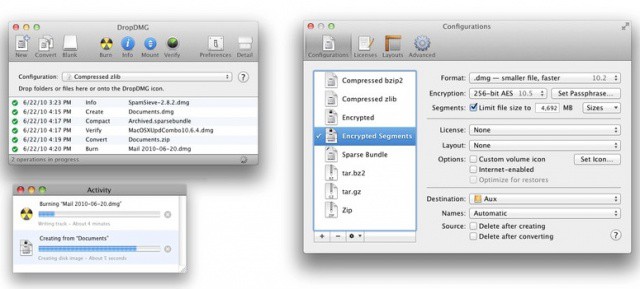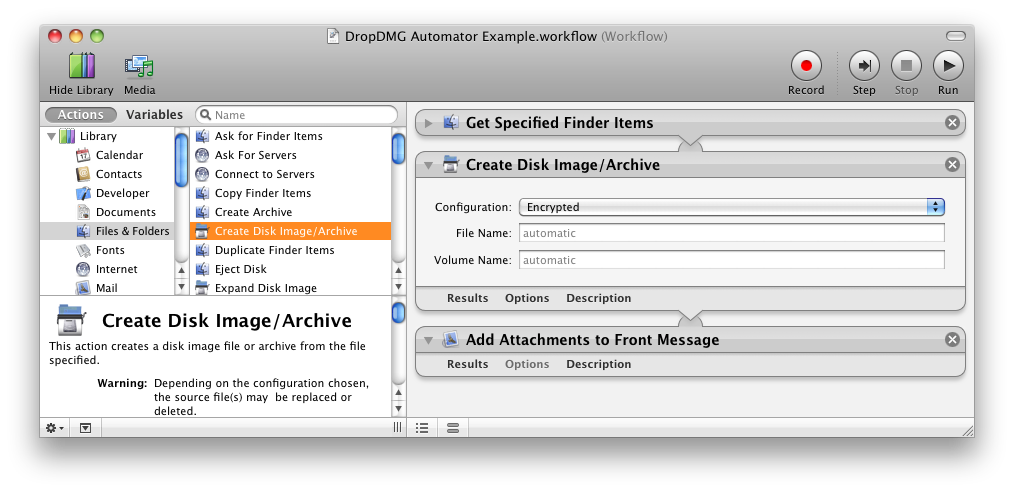
- #DROP DMG HOW TO#
- #DROP DMG SOFTWARE LICENSE#
- #DROP DMG ARCHIVE#
- #DROP DMG SOFTWARE#
- #DROP DMG TRIAL#
#DROP DMG TRIAL#
You can download a full-featured trial version here.
#DROP DMG HOW TO#
Possessing the appealing looks and effortless maneuverability typical of the Mac OS platform and accompanying software, it’s extremely easy to understand how to use it effectively. This is especially important when you make encrypted backups and archives for safe off-site storage.ĭropDMG is a very useful piece of software. The option of verifying an image comes handy if you want to check that all the files inside it are as they should be and not corrupted. To burn a file, folder or disk image to CD, DVD, or Blu-ray, press the “Burn” button, choose what and how do you want it “burned”, then chose the medium: The “Info” button obviously shares with you the technical details regarding a disk image. You can also create a blank disk image and drag and drop items in it subsequently: Instead of dragging and dropping what you need into the software, you can also use the “New” button.
#DROP DMG SOFTWARE#
and join them into file.Īs you can see, there are plenty of things this software is capable of. If you give it a file such as file.001, DropDMG will look for file.002, file.003, etc. dmg disk image with the specified options. DropDMG is the easiest way to create macOS disk images, which pack entire folders or disks into a single compressed file, either for transport across the. sparsebundle), DropDMG will convert it into a. If you feed it a disk image file (e.g.dmg or. dmg format) that is an exact copy of the volume. If you give DropDMG a volume, it will create a special device image (in. dmg disk image whose contents are the contents of the folder. If you drag and drop a folder into the software, it will create a. Let’s say that you’ve set DropDMG to create compressed. Well, now you can continue to test the software.

#DROP DMG SOFTWARE LICENSE#
The goal is to create an output file that matches the options you’ve chosen in the preferences, so defining them might be the best way to start using the software.įor when you want to deliver your Mac application with a localized software license agreement, a background picture and precise icon layout, and a custom volume icon, customize a license agreement:Īnd design the layout of the image once it’s mounted and accessed:Īdvanced preferences include the option of installing a command line tool and operations for the software to do or be allowed to do:
#DROP DMG ARCHIVE#
I still use this for ALL archives not requiring a custom layout and/or license.DropDMG (v3.0.6) is a piece of software that helps you create and work with Mac disk images – Apple’s preferred format for distributing Mac software and the only archive format whose contents you can directly access in the Mac Finder.ĭisk images pack entire folders or disks into a single compressed file, either for transport across the Internet or simply for backup.ĭropDMG automatically determines what you want it to do based on the files or folders that you give it. I hope the layout features of DropDMG are enhanced to match the excellence of the DMG creation ones. Unlike the finder itself, filenames in DropDMG's layout do not appear to be able to extend to 2 lines. The Layout setup allows the choice of the position of the upper left corner of the final DMG window, but lacks a way to specify the SIZE, auto-conforming it's size to that of the background image.

I created a background image with 6 regularly placed spaces for icons, but instead of the 6 icons falling into those spaces in my 3 x 2 grid, DropDMG decided to allow the icons to bleed off the background image in a 2 x 3 arrangement) This CAN actually be accomplished by nudging except the grid scale cannot be changed.Īll my attempts to accomplish the reverse to create graphics in such a way that the icons placed automatically by DropDMG would happen to align with them, failed. While it's nice having a grid to to allow easy alignment when positioning icons, there's no way to set the grid to have a correlation to that of the finder to allow proper alignment of icons with background images. However, I'm still finding the relationship of Layouts to configurations to the final creation dialog choice awkward.Īs the automated replacement of custom positioned icons in a layout requires filenames EXACTLY matching those in the folder from which the DMG is created, the feature is fairly useless except to a Dev releasing software & updates where the same set of files will be used each time. The features which were available in version 2 are even better and still deserve 5 stars Version 3 has more features and a new interface so it deserves a new evaluation including them.


 0 kommentar(er)
0 kommentar(er)
